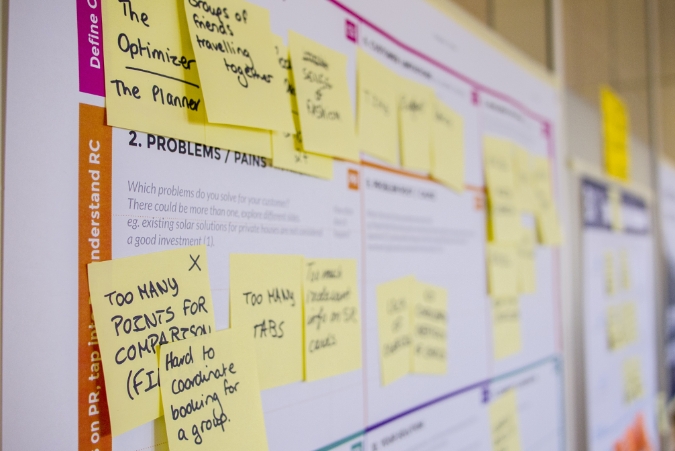On a ‘journey’…

O wad some Power the giftie gie us, to see oursels as ithers see us! (Robert Burns, ‘To a louse’)
Don’t worry about trying to understand the Scots language, this famous quote from Burns is often used to remind us of the value of ‘feedback’ (in modern terms…). In other words it’s vital to understand how we appear to others, in terms of our presence, behaviour, words and actions, interactions with others. If we had that power – to be able to realistically see how we engage and are perceived by friends, colleagues and others in life and work, that truly would be a super power. Imagine if you could clone yourself and secretly watch your colleagues talk about you when you go for lunch, or what people are actually saying when you leave a room…?!
Businesses also need to get unfiltered feedback on what they do and how this affects their customers – they can’t just assume that they are succeeding without some external and independent view of the quality and impact of their services. We know that there is a need to capture ‘customer feedback’, ‘employee feedback’ etc as part of service performance reporting, but there’s more than that.
Organisations, service teams, companies and departments are all great at defining what they do, turning these into processes and ways of working and then assuming that success means just delivering against these processes. The reality of course is that the services created and delivered through these processes are then consumed and experienced by people – who may then have a completely different experience to that which is intended. So whilst it’s important to measure the delivery of these processes, this will never be sufficient to fully appraise the quality of delivery and also the emotional reaction of those receiving the service. Feedback surveys are useful and can pick up some aspects of this, however a more personal and specific approach is needed to really understand what it’s like to be a customer – to ‘take a walk in the customers shoes’ and ‘see ourselves as others see us’.
‘Taking a walk’ is a good reference here as, in many cases and particularly with service management, this is not simply a single event or binary transaction. Often the users or consumers of IT Services have multiple ’touchpoints’ with the teams and individuals who are delivering products and services to them. Touchpoints are the points of interaction when a consumer comes in to direct contact with people, or systems or other artefacts that are part of the ‘delivery’ of a service – these are often fluid and difficult to create consistently, and are therefore often where a service and company can win lifetime loyalty or lose credibility and future business.
Retail and hospitality businesses in particular have understood this for years and spend a lot of time working on the customer journey – how you enter a store or hotel lobby, what your eyeline sees, what you hear or smell, how you are greeted, what questions you are asked and how you are served or communicated with from there on etc. You may enter a beautiful hotel building and be greeted by a disinterested receptionist who gets your name wrong and doesn’t communicate your preferences with others in the hotel, the room may be perfect but your experience has already been tarnished – you take your future business elsewhere.
Service organisations need to experience this for real from the outside, in order to reduce the risk of this happening again. How did this happen? What sort of people need to be in reception, what training, tools and awareness do they need? How do we communicate across teams and maintain a great experience for our customers?
This is the ‘customer journey’ and journey mapping is a technique used across industries – and more regularly in service management and IT.
Front of house and backstage…
Going to the theatre involves interactions with ‘front of house’ people – buying tickets, selling drinks and ice cream, showing you to your seats, managing security and safety as well of course as enjoying the show delivered by actors, musicians, singers and dancers. Theatre goers don’t see (and also don’t need to see or understand) what’s going on behind the scenes backstage. This of course involves a whole number of people, technology and ‘processes’ to make the whole experience work – from accountants to dance coaches, composers to stage hands, lighting operators, sound engineers, set designers, stage managers, costume-makers and others.
In order to ensure that the theatre operation and the experience of going there are all working successfully, the organisation needs a front stage/backstage view of both the audience experience (warts and all) and also the effectiveness and seamless integration of the backstage operation.
In a similar way, if we are running and IT Service operation, we need to map and review the end-to-end delivery form our own (backstage) perspective – this is value-stream mapping, looking at all the elements that go to delivering a service.
In addition we need a customer journey perspective to understand in practical terms what the user experience is of engaging with us – using a portal or call a service desk, getting a reference, discussing our issue or requirement, and getting this delivered. Recent developments and approaches such as ITIL4, DevOps and others have identified mapping (value streams and customer journeys) as key to really being able to define and continually improve the quality of services.
Value streams and customer journeys
Mapping of these involves both internal and external activity – i.e. working with your own team and partners to build up a view of the collective ‘value stream’ for a service – ie not just a single process like incident management. In addition it is necessary to engage with some users or your service to ‘walk through’ their experience of engaging with it, how it made them feel and their reaction, as well as their levels of satisfaction.
Customer experience (CX) has been a major force of discussion and interest in the ITSM industry over the last 4/5 years – how to identify and map out the customer journey and capture their direct emotional responses to the service experience. This is now a specific capability that is needed to manage and improve the customer experience.
Value streams are also a focus for discussion as central components of ITIL4, DevOps and other approaches. This is an internal holistic view of how services are delivered across teams, processes, people and tools. The goal is to identify areas of blockage that can be improved and removed to improve efficiency.
Together these two techniques are essential tools in the ITSM practitioner’s practical portfolio.
Here are some tips for how to approach mapping:
Customer Journey mapping
- Use friendly customer groups initially to develop the technique of good mapping
- Leave your knowledge of how IT works behind…
- Use role-play initially if it is difficult to get customer/user time
- Use simple wall boards to map out the experience of using your service – from the user/customer’s perspective
- Don’t go into solution mode when customers are expressing themselves – show empathy and that you are listening
- Use real historical incidents/requests/changes/problems
- Work through a few standard interactions, e.g.
- A single-user access incident – that requires escalation
- A standard request – to e.g. order a PC or access
- An emergency request – a late request for access and kit
- A problem or change – a recurring issue and how IT handles it
- A complaint – about speed of service and/or quality of response
- A major incident – everything that is important is down…
Value Stream Mapping
- Use small local value streams if possible initially to develop the experience of mapping
- Map the value streams for the interactions as above
- Use role-play if necessary – or use real historical incidents/requests/changes/problems
- Rotate the roles of user, IT listener, observer
- Role-play is great – avoid it getting personal
- No blame culture – we all are here to learn and improve
Here more on this topic on my next Brightalk webinar on Thursday 19 November, 16:00.
This session explains the functions, benefits and challenges of mapping – internal work (value streams) and external experience (customer journeys). This is for those who are attempting to move to this way of working and quantifying their work inputs, outputs and outcomes. Join me to hear about how to do this using some existing and new techniques, plus also how to combine and analyse the output.
I will be at the itSF Uk virtual conference on 16 and 17th November – if you are attending I look forward to seeing you there and discussing service management topics and issues.




